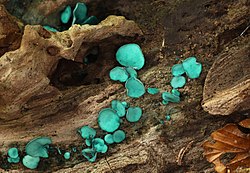| Chlorociboria | |
|---|---|
 | |
| Chlorociboria sp. | |
| Scientific classification | |
| Kingdom: | Fungi |
| Division: | Ascomycota |
| Class: | Leotiomycetes |
| Order: | Helotiales |
| Family: | Chlorociboriaceae |
| Genus: | Chlorociboria Seaver ex Ramamurthi, Korf & L.R.Batra (1958) |
| Type species | |
| Chlorociboria aeruginosa (Oeder) Seaver ex C.S.Ramamurthi | |
| Species | |
23, see text | |
Chlorociboria is the type genus of in the fungal family Chlorociboriaceae within order Helotiales. The genus includes 23 species. [1]
Contents
Two common temperate zone species, Chlorociboria aeruginascens and Chlorociboria aeruginosa , can only reliably be distinguished by microscopic examination. Chlorociboria aeruginosa has larger spores (9–15 μm × 1.5–2.5 μm) and the worm-like cells of the outer surface are rough, unlike the commoner C. aeruginascens, of which the spores are 6–10 μm × 1.5–2 μm.
The hyphae and fruit bodies of all species make xylindein, a secondary metabolite that stains the substrate wood blue-green, with "green oak" being a valued commodity in woodworking. [2] The blue-green pigmented wood is featured in Tunbridge ware.